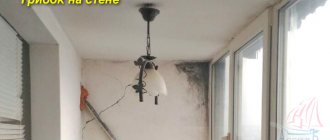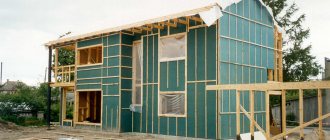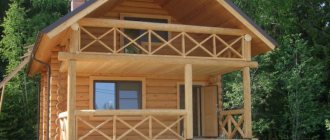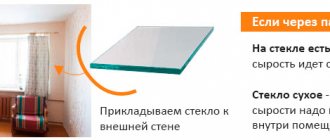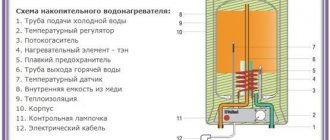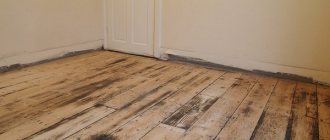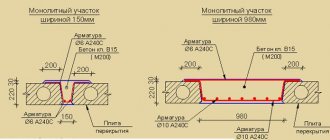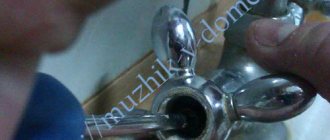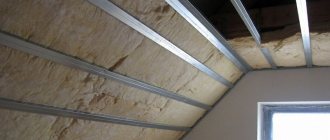Home / Questions and Answers / Corners in a panel house freeze, what should I do? / Cracks in a panel house on the street side, what should I do? / Why do plastic windows cry and how to deal with it in a panel house? / We insulated the balcony, condensation has appeared and the corners are getting wet / The corners in the panel house are freezing, what should I do? / Repair and waterproofing of the roof of the top floor balcony. What is the price? / After external insulation, the walls continue to be damp: what to do? / How to insulate an apartment in a panel house and reduce heat loss in the house? / Is it worth installing a canopy over the facade insulation? / How to seal the seams between floor slabs? / How to fix a balcony leak? Waterproofing a balcony on the top floor / Waterproofing a bay window and what to do if a bay window P-44, P3M is leaking? / Waterproofing a balcony ceiling, eliminating leaks / How much does an industrial climber earn in Moscow? / How to seal seams with sealant in a wooden house? / Hydrophobization of façade walls made of concrete and brick, what is it?
Freezing of a wall in a panel house: reasons
The main reason for this problem is the design of the panel house itself. And it must be said that frozen walls in such buildings are a pressing, widespread problem. Such buildings are built from panels consisting of three layers. The outer and inner ones are made of concrete, and between the layers of concrete there is insulation. This can be polystyrene foam, mineral wool or other insulating material.
Such panels are connected by welding, and a special sealing cord is inserted into the resulting joints between the plates. The joints are sealed with mastic. The result is a monolithic structure, without cold bridges. But this is ideal. But in fact, the installation of the panels is carried out with violations, so the gaps are defective. Moisture gets into these defects, penetrating into the panel and into the insulation.
Getting rid of freezing corners
The ideal way to solve the problem is to insulate the entire facade from the outside and reliably seal the seams. It is quite possible to repair your own country house, but in an apartment building you will have to turn to the management company for help. But don't despair. And in a separate apartment you can get a good result.
First of all, you need to remove the wallpaper. If there are no visible cracks, then the walls are tapped with a hammer - where there are voids, the sound will be dull. Next, remove the plaster over the detected cavities and thoroughly dry the corner. If there is mold, be sure to treat it with special antifungal agents. Sometimes mold damage is so extensive that the use of acid, blowtorch fire, or milling of the surface is necessary. All cracks and voids are filled with polyurethane foam or liquid foam. This will prevent moisture from entering the room even if there are cracks in the external wall. Finally, they clean off the remaining foam and plaster the corner. It is best to carry out work in the warm season in order to completely get rid of dampness and mold indoors.
If very large voids are found, you should not fill them with mineral wool or tow, as these materials contribute to the accumulation of moisture. It is better to use the same polyurethane foam. It is resistant to moisture, not susceptible to rotting and mold, has high adhesive properties, and does not lose quality when frozen.
Insulation of the entire façade from the outside
Today, manufacturers offer a variety of materials that greatly facilitate the repair process and take it to a whole new level. For example, special heat-insulating (“warm”) plasters are light mixtures in which microscopic polystyrene foam granules or lightweight natural fillers are used instead of sand. This plaster is several times lighter than regular plaster, it applies and sets well. Due to the presence of air pores, warm mixtures have high vapor permeability, regulate condensation and provide a healthy indoor microclimate. A 50 mm layer of warm plaster has a thermal insulating effect equivalent to one and a half to two bricks or a two-centimeter layer of polystyrene foam.
Not long ago, new materials appeared on the market, produced by different manufacturers under different brands, but united under the common name “liquid thermal insulation”. It is indispensable for problem areas such as freezing corners. The insulating suspension, reminiscent of paint, consists of hollow microspheres (ceramic, glass, silicone or polyurethane) that effectively reflect thermal radiation. Microspheres are suspended in a binding composition of synthetic rubber or acrylic polymers, antifungal and anti-corrosion additives and coloring pigments. This composition gives liquid thermal insulation the properties of waterproofness, flexibility, lightness and strength. The thermal conductivity of liquid heat insulators is significantly lower than that of conventional insulation. Several layers of such paint can replace 5 - 10 cm of polyurethane foam or mineral wool.
True, all this is only from the words of manufacturers and sellers; many practical tests have proven the ineffectiveness of such paint as insulation. Its main task is to reduce heat loss on hot water pipes and boilers.
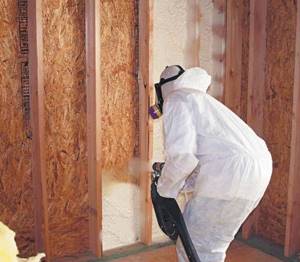
Application of liquid insulation
The problem of corner freezing can be prevented even at the stage of building a house or renovating a new building. In accordance with the laws of physics, the temperature of the inner surface of the corner is always lower than the temperature of the walls that form this corner. Experienced designers say that ideally the corners of walls, both external and internal, should be rounded or beveled. Rounding or chamfering only the inner corner (with wall material or heat-insulating plaster) can reduce the temperature difference between the walls and the corner by 25-30%. The same role is played by pilasters on the outer corners of the building. This is not only a well-known architectural technique, but also a method of additional insulation.
You can use interesting design solutions. For example, in the corner of the ceiling, mount a plasterboard box with lighting from ordinary incandescent lamps. Working lamps will heat the air inside the structure, thereby moving the dew point inside the wall.
These articles may also be of interest to you:
- Is it possible to match plastic windows to the color of the wood at home?
- Insulation of the house. Thermal insulation of a house according to the rules
- Insulation of external walls with mineral wool. Step-by-step instruction
- Construction of a house from laminated wood panels
Why is moisture in insulation harmful?
Water is a good conductor of heat, so a wet insulating material can no longer perform its functions, and the wall becomes colder. As a result, the dew point moves closer to the inner surface of the wall. This displacement leads to the fact that moisture accumulates even more inside the walls and does not become colder. In many cases, the wall is cooled to 0 degrees not from the outside of the panel, but inside, in the insulating layer, or closer to the inside. Accordingly, the water inside the panel freezes in winter - we get freezing of the walls.
After several years of such freezing followed by thawing, the insulation simply collapses and loses its properties.
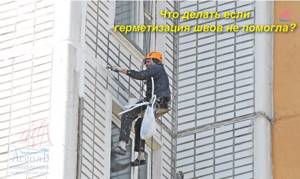
No additional insulation
If you live in a region with a minimum number of warm days a year and very cold winters, then condensation will certainly form on thin walls and joints. This is explained by the fact that it is warm in the apartment of a panel house, but not outside. Due to this temperature difference, condensation forms at the most vulnerable points of the wall - the corners. Reacting with the sub-zero temperature outside, the moisture freezes and hardens on the walls.
The wall freezes, sealing the joints does not help. What is the reason?
Quite often, apartment owners in prefabricated buildings encounter freezing of the walls. Contacting the HOA or the management company does not bring results. More precisely, the management company or homeowners association claims that the root of the problem is poorly sealed seams, they are being repaired, the joints are sealed properly... But the wall continues to freeze. The reason for this phenomenon is simple: while the joints were not sealed, water leaked into the panels, and it did not go away. And if there is moisture inside the panel, freezing will naturally occur. What to do in such cases? Naturally, the problem must be solved individually, but a certain general algorithm of actions exists.
will solve your problem!
Specialists approach solving the problem of freezing corners with full responsibility:
- They carry out diagnostics: they check the quality of the brick, masonry, foundation, the quality of construction work (whether the technology for flashing corners is followed), the presence of cracks on the walls.
- After the diagnosis, they give a conclusion on what is the best way to solve the problem (whether major repairs are needed, whether the wall needs to be rebuilt, additional masonry, i.e. what kind of restoration and insulation work will help eliminate the root cause and prevent further freezing of the corners once and for all). They recommend the method of external finishing and facade materials (ventilated, plaster facade, siding). They are preparing a work plan.
- After agreement with the customer, the necessary work is performed. High quality and in the shortest possible time.
Contact us! Our team is always ready to help. Artel-Stroy specialists have completed façade work on many sites. You can be sure that you have the relevant experience. Competent consultants are always ready to guide you through the range of materials and services of the company. We work in Lipetsk and throughout the region. Travel to neighboring regions is possible. Photo gallery of facade works
What to do if it is not possible to conduct a thermal imaging examination?
Then the wall is examined independently; signs of freezing are mold, mildew, and condensation. By touch you can identify colder areas - this indicates that there are metal embedded parts in these places. And very often they are located where the project does not provide for this. The logic of the builders is very interesting in this regard.
Colder sections of the wall are also found where there are voids, or where the insulation is not yet heavily waterlogged. Such places can be found by simply feeling the wall with your hands. It would also be good to determine the places of through blowing - to do this, you need to run a lighter or a burning candle along the walls. It is especially important to pay attention to joints, baseboards, panels, slopes, and window openings. It is best to check by removing the wallpaper from the wall so that the joints are visible. If the apartment is on the top floor, it is worth checking more carefully where the panel adjoins the parapet - very often moisture leaks occur through a poorly made roof.
Leakage of moisture through the roof is an important point. The parapet slab is thinner than the wall slab, and if the roof leaks, 100% of the water goes into the wall. It is better to conduct an inspection of the joint with a representative of the management company; after identifying defects at the junction of the wall and the parapet or the drainage system from the roof, repairs will have to be carried out by the management company. What should be done? Seal the panel joints, repair the roof if necessary, and be sure to dry the wall.
How to prevent corners in your home from freezing
To prevent corners from freezing, it is enough to resort to some architectural changes. For example, round or bevel corners in a house. You can significantly insulate the walls inside using pilasters on the outer corners of the building. To prevent the appearance of condensation, you can use non-standard and interesting design solutions: fix a plasterboard box with decorative lighting from traditional incandescent lamps under the ceiling in the corner. The outgoing light flux will not only illuminate the room, but also heat the surrounding air, thereby preventing the appearance of moisture and mold.
If your house is made of logs, then at the time of its construction you should carefully fasten the crown logs in the corners with a cut lock using thermal insulation materials. Such measures will reliably protect the wooden house from freezing corners.
Many residents of modern high-rise buildings, and even owners of their own houses built in violation of technology, are faced with the problem of freezing walls. As a result, you get frost on the walls, dampness, mold clumps and health problems.
The reason for such difficulties can be insufficient thermal insulation or its defects, poor-quality material from the wrong manufacturer from which the walls are built, as well as violations of the seams, poor performance of the ventilation or heating system, or violation of the rules of operation of the building by the owners themselves.
The consequence of each of these violations can be excessive humidity and the appearance of fungus, which not only corrodes the structure, but is also harmful to health! If a fungus appears in the house, then no repairs will save it and everything will be destroyed! We'll have to figure out the cause of the freezing.
To prevent walls from freezing and their subsequent destruction, it is necessary to constantly ventilate the premises or immediately install correctly calculated ventilation, not to store items of high humidity in the room, and of course, to avoid problems with the plumbing!
If you notice that the walls are starting to freeze, don’t worry! Correcting the situation is possible and not so difficult! It is best to do a few simple operations and the problem of damp walls will be eliminated!
Your actions to solve the problem:
If the seams between the materials are in unsatisfactory condition (cracks have appeared, etc.), then this is the main reason for freezing! Fix the cracks in the seams and most likely the problem will be solved. If the cracks are located, for example, in a five-story building, then contact a company specializing in industrial albinism. It's their job, don't risk your own life trying to fix the holes by hanging from the window!
Having previously destroyed the fungus, start insulating the walls. If the fungus has started in utility rooms where there is high humidity, such as a bathroom or toilet, then you need to check the air ventilation system! Apply a match to the ventilation shaft; if it works properly, the fire will be drawn into the shaft. In apartment buildings, the companies servicing the building are required to clean the ventilation; call a meeting of the HOA and go demand that the management company remove the blockage in the ventilation. Owners of private houses or buildings can contact specialized companies!
Insulation of internal walls should be carried out as follows:
- Clean the walls from “cosmetics” (wallpaper, putty), if cracks appear, putty them or seal them with polyurethane foam. If a fungus is detected, immediately destroy it with special solutions.
- Then you need to treat the walls with an acrylic primer with deep penetration.
- Then you need to apply an insulating mixture to the walls; instructions on how to apply it will be written on the packaging.
- After all layers of thermal insulation have dried, you can continue “cosmetic” repairs (glue wallpaper, putty, paint).
external walls
When this cold bridge comes into contact with the warm air of the room, the following physical phenomenon occurs on its surface - a “dew point” is formed, i.e. water vapor contained in the air begins to condense and turn into droplets. The wall begins to get wet in this place, and in winter, when the temperature drops, it naturally freezes. Another consequence of freezing walls in the house is the appearance of mold. Mold fungus, in addition to spoiling the appearance of the room, is also extremely harmful to human health and can cause pulmonary diseases and allergies. Factors contributing to the walls freezing in the house are poor ventilation and insufficient heating of the room.
Wet corners in a panel house
Hello. My family lives on the fifth and last floor in a panel house. At one time, we insulated the corner walls (35 cm) and sections of the wall under the windows. We used 40 mm thick polystyrene foam, plastered it on top and hung wallpaper. Also, new triple-glazed plastic windows were installed. There is no high humidity in the apartment, but condensation constantly forms on the windows, as a result of which the slopes become moldy. Sometimes wet areas and mold spots appear on the ceiling in the area of the corner wall, even if it is not very cold outside, up to -5 degrees. Wetting gets worse when food is being prepared in the kitchen.
The roof is insulated with isover, and roofing felt is laid on top of the insulation. The heating in the apartment is good, the radiators are hot, but the rooms are cool, the temperature does not rise above 21-22 degrees, quite cold. Tell me how to get rid of wet corners and condensation? We live in the city of Uralsk, in the West Kazakhstan region. Basil.
Ways to get rid of freezing of walls and corners in a brick house
If a corner freezes and its structure is clearly damaged, that is, it has cracks or severe deformations, then polyurethane foam serves as an excellent means of combating similar problems. It is quite simple to use, and to carry out the work you will need no more than half an hour of free time. At the same time, blowing out voids and sealing cracks should limit the access of cold air into the room, which will help get rid of the negative consequences of wall freezing.
Heat-protective plaster can also be a pretty good option. However, its use is possible only in those places where freezing is not too obvious. This criterion is incredibly important, since a relatively small layer of plaster is simply not able to isolate large flows of cold air.
In general, the best option is to combine both of the above methods. In this case, the crack is first blown out, and then a layer of thermal insulating plaster is applied. Combining these insulation options makes it possible to completely eliminate freezing of corners and restore the microclimate in the room.
Insulating the surface by applying a thermal insulation layer to it is also a good solution. However, the greatest efficiency can only be achieved by creating a solid monolithic layer that will cover the entire wall. At the same time, a similar technique can be used both on the inside of the building and inside it.
Most often, for similar work, polystyrene foam is used, which is glued directly to the wall, and the junctions of the sheets with each other are covered with a special reinforcing putty, providing the given section of the wall with the necessary heat preservation qualities.
Regardless of the material from which the house is built, be it wood or brick, you can often encounter such a problem as freezing of the corners.
The reason for this is not only the laws of nature, but also the mistakes of builders. The fact is that any corner is a kind of bridge of cold.
If during the construction of a house the builders saved on insulation or mortar in the brickwork, then the cold will penetrate into the home through the voids.
In winter, as a result of the temperature difference between indoors and outdoors, condensation may occur in the corners. This is what causes mold and cold to occur.
The first thing that comes to mind when deciding to solve the problem of freezing corners is additional insulation of the house from the inside. But this is far from the best option.
The internal thermal insulation of the house shifts the “dew point” inward, as a result of which the walls become damp in winter, which means their untimely destruction.
As a result of such insulation, freezing of corners can only intensify. Therefore, the only correct solution is insulation from the outside.
What to do if the corner of the house freezes
Owners of country houses most often face the problem of constantly freezing corners. But in winter, residents of panel high-rise buildings often have to deal with the formation of moisture, cold and mold in the corners of the apartment. In some cases, the situation reaches the point where, in addition to the fungus, ice begins to form inside the house, which, in combination with green, black and yellow mold, creates a terrifying picture.

Before starting work on insulation from the inside of the home, believing that this is the only way to solve the problem, it is worthwhile to figure out why exactly the corner in the house freezes.

